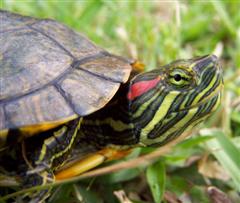Red Eared Slider
Scientific Name: Trachemys scripta elegans
Sat, 14th June, 2025 - 6:37 pm GMT
Sponsor Ads:

Alternative Name
Scientific Name: Trachemys scripta elegansBasic Info
Bright bands on the sides of the Red Eared Slider's head are where they get their name. These bands are not always red, often varying from orange to an almost brick red color; and sometimes they do not appear at all. These bands may also be broken into a few spots and can fade with age. They sometimes also have a spot the same color as their bands on the top of their head. It is not rare to find them now as albino or pastel varieties. When Red Eared Sliders are born, both their carapace and their bodies are a vibrant green. In young adults the shell will often go through a yellow stage, and eventually become olive in color. The carapace at this time is also covered with dark patches, streaks, and lines, as well as patterning in yellow, white, and red upon occasion. The carapace changes colors with age, often turning brown, gray, or even black; and after a time, you have to look closely to see the bands on the sides of their heads, which fade in with these colors. A Red Eared Slider can reach an adult length of anywhere between 5 and 12 inches. Females tend to be larger than males. Males have longer tails than the females and have long front claw nails, which they use in their breeding dance.
Health
Red Eared Sliders require a land and water set up. The land end should slope into the water and can be easily built with aquarium rock and gravel. On the water side you need to maintain a water depth that is at least the length of your turtle's carapace. This ensures that the Slider can easily right itself if it becomes turned around while swimming. Keep a canister, under-gravel, sponge, or power filter in your turtle's aquarium. The water needs to be kept as clean as possible, and even with a filter you will need to change the water frequently. Water quality is the number one challenge when caring for any aquatic turtle. How often water is changed, is determined by the ration of gallons of water per turtle, and whether or not a filter is used. In addition different types of foods can cause the water to become dirty faster than others. In addition to visible waste, which should be removed with a net as soon as it is seen, there are other waste products that are produced which are not visible to the eye. One of the most important to recognize is ammonia. There will always be some ammonia present in the water, but filtration is necessary to prevent too much. Excessive ammonia can cause turtles to become quite sick. Bacteria may also grow in the water, and a teaspoon of salt per gallon of water is a good way to reduce bacteria levels. Red Eared Sliders need fairly warm, but not too warm, water; a good temperature range is 75 to 85 degrees Fahrenheit, and you can monitor and maintain this with a water thermometer and a submersible pre-calibrated heater. Maintain a general air temperature of 75 degrees Fahrenheit. Use an incandescent bulb or ceramic heater to heat up a basking area to a temperature of 85 to 88 degrees Fahrenheit. Your Red Eared Slider should also be provided with full spectrum lighting for about 13 hours a day, so that it can properly utilize calcium. When the weather is suitable, monitored trips outside or outdoor enclosures are also a good idea. Commercial diets found in pet stores, such as turtle and trout food, can be given to Red Eared Sliders; however, this should supply no more than 25% of what they eat. Another 25% should be composed of cooked chicken, chopped lean raw beef, earthworms, crickets, feeder fish, and occasionally low-fat dog and cat chow (a premium brand). These items will supply your Turtle with the proper amount of protein. The other 50% of a Red Eared Slider's diet should consist of vegetation such as dandelion, mustard, and collard greens, green beans, squash, and carrots. Some also enjoy an occasional banana. Feed adults every two to three days. Young Red Eared Sliders should receive a higher animal protein diet every day. Cuttlebones and calcium blocks will also make good additions to your turtle's set-up. It should be noted that feeding turtles outside of their tank can greatly reduce ammonia buildup. Also, allowing feeder fish to live in the tank, or pond can also increase ammonia levels. If your turtle is showing any signs of a health problem such as open sores, bloating, runny feces, breathing through the mouth or wheezing, or if their eyes are swollen or not clear, take them immediately to a veterinarian to assess the problem. If you catch a problem early and treat it exactly as directed, these turtles can bounce right back, and hopefully all future problems can be avoided. Red Eared Sliders may be prone to eye infections and shell-rot. Both of these may be prevented with proper sanitary and dietary care. Shell and skeletal deformities can result from vitamin deficiencies or imbalances, which, in captivity, often are the result of insufficient UV exposure. Breeding Most Red Eared Sliders begin breeding once they are 5 inches in length. It has been reported that size is more important than age for sexual maturity in this species. The mating rituals that occur between male and female Red Eared Sliders are interesting to watch. The males will first spend a long time trying to move the females into a position where they can face them. They then wiggle their long front claws in front of her. After some biting on the neck, the actual process of mating will take place. Females lay a number of clutches throughout the year and the hatchlings are fairly hardy, often times over-wintering, if they cannot leave the nest at the time of hatching. Proper incubation means carefully moving the eggs to a plastic container containing moist vermiculite. Don't rotate them, and keep them right-side up as you move them. Control the water content in the box by weighing it at the beginning and maintaining this weight throughout incubation. Clutches typically contain 12 to 15 eggs and will hatch in 50 to 62 days, if properly incubated at a temperature of 80 degrees Fahrenheit. House hatchlings in the same way you do adults but change their water daily.Habitat
Found in the United States in Mississippi, Alabama, New Mexico, Louisiana, Texas, Arkansas, Kansas, Oklahoma, Kentucky, Illinois, Missouri, Tennessee, and IndianaBehavior
The Red Eared Slider is the most commonly kept turtle in the pet trade. Their popularity may be due to their good looks and relatively easy care. The Red Eared Slider makes an excellent pet, as long as the owner is responsible in their upkeep. They do very well with other turtles of their species and make excellent additions to outdoor ponds, if you live in a suitable climate. Like all turtles, they require a good deal of attention in maintaining their health and keeping them free of parasites. All of this can be done with the proper amount of attention to the turtle's behavior. These turtles are, unfortunately, often discarded when owners do not realize the amount of space these turtles will one day take up. Be prepared to house a fairly good-sized aqaurium if you are planning on keeping adults indoors. Large adult individuals may require up to 150-gallon tanks or better still, a pond if the outdoor environment is conducive. These turtles are very amusing to watch, and are usually quite active and entertaining. When adding new sliders to your tank or pond, it is a good idea to get a fecal exam before placing them with other individuals. This helps to prevent the spread of disease. Some diseases may be asymptomatic for long periods of times. While Red Eared Sliders are very popular and often purchased for children, this may not be the best choice, because they do grow to very large sizes, and as sizes increase, their care does become more difficult and expensive. This, along with their long lifespan should be taken into consideration before making a purchase. Turtles require much more frequent aquarium cleaning than some people realize. This should also be considered before purchase. Animal Rescue Organizations across the United States are currently caring for a large number of these turtles that were purchased hastily and later became inconvenient or impossible for their owners to house. The average lifespan of the Red Eared Slider is between 20 and 25 years, though some individuals may live as long as 40 years.Origin
North AmericaHistory
The Red Eared Slider can be found in the United States in Mississippi, Alabama, New Mexico, Louisiana, Texas, Arkansas, Kansas, Oklahoma, Kentucky, Illinois, Missouri, Tennessee, and Indiana. Red Eared Sliders have also been introduced into the wild in places such as California, where unprepared and irresponsible owners have essentially dumped them in local water areas. The Red Eared Slider is a freshwater Turtle, and can be found near lakes and ponds. If you would like to save a cast-off Red Eared Slider, this can be easily done in many areas through animal rescue and adoption organizations that are concerned with the well being of this wonderful animal.Common Foods
N/ASponsor Ads:
"Pity the meek, for they shall inherit the earth"
Red Eared Slider
Coded by: BGID® | ALL RIGHTS RESERVED Copyright © 2000-2025
Disclaimer | Privacy | Report Errors / Contact | Credits








 President of the United States of America - Real Estate mogul, Pageant owner and now one of the most controversial men in political history.
President of the United States of America - Real Estate mogul, Pageant owner and now one of the most controversial men in political history.  Global warming has been in and out as the "latest" hot topic for many years. It is, according to modern scientists, the result of man-made industrial pollutants, clearing forested areas, agriculture, etc. But now they are thinking it started way before the Industrial Revolution...
Global warming has been in and out as the "latest" hot topic for many years. It is, according to modern scientists, the result of man-made industrial pollutants, clearing forested areas, agriculture, etc. But now they are thinking it started way before the Industrial Revolution...  Politician, US Vice President and President of the USA - Joseph Robinette Biden Jr.
Politician, US Vice President and President of the USA - Joseph Robinette Biden Jr.  versus
versus  Russia: 'The Evil Empire'? Are they all that bad or is it just the USA trying to portray Russia as bad because they are a world power with land bigger and a society very different from the USA ideal?
Russia: 'The Evil Empire'? Are they all that bad or is it just the USA trying to portray Russia as bad because they are a world power with land bigger and a society very different from the USA ideal? 
 Corona virus
Corona virus 
 Users with wide screen monitors can benefit from more content on every page.
Users with wide screen monitors can benefit from more content on every page.